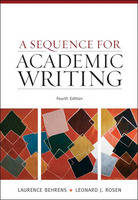
A Sequence for Academic Writing
Pearson (Verlag)
978-0-205-67437-4 (ISBN)
- Titel erscheint in neuer Auflage
- Artikel merken
Preface for Instructors
Note to the Student
Part One: Structures
Chapter 1—Summary, Paraphrase, and Quotation
What Is a Summary?
Can a Summary Be Objective?
Using the Summary
Box: Where do We Find Written Summaries?
The Reading Process
Box: Critical Reading for Summary
How to Write Summaries
Box: Guidelines for Writing Summaries
Demonstration: Summary
Will Your Job be Exported?- Alan S. Blinder
Read, Reread, Underline
Divide into Stages of Thought
Write a Brief Summary of Each Stage of Thought
Write a Thesis: A Brief Summary of the Entire Passage
Write the First Draft of the Summary
Summary 1: Combine Thesis Sentence Brief Section Summaries
Summary 2: Combine Thesis Sentence, Section Summaries, and Carefully Chosen Details
How Long Should a Summary Be?
Exercise 1.1: Individual and Collaborative Summary Practice
Summarizing a Narrative or Personal Essay
Dreams of Patagonia—Bruce Chatwin
Box: How to Summarize Personal Essays and Narratives
Summarizing Figures and Tables
Exercise 1.2: Summarizing Graphs
Exercise 1.3: Summarizing Pie Charts
Exercise 1.4: Summarizing Line Graphs
Exercise 1.5: Summarizing Tables
Paraphrase
Box: How to Write Paraphrases
Exercise 1.6: Summarizing and Paraphrasing
Exercise 1.7: More Paraphrasing
Quotations
Choosing Quotations
Quoting Memorable Language
Box: When to Quote
Quoting Clear and Concise Language
Quoting Authoritative Language
Incorporating Quotations into Your Sentences
Quoting Only the Part of a Sentence or Paragraph That You Need
Incorporating the Quotation into the Flow of Your Own Sentence
Avoiding Freestanding Quotations
Exercise 1.8: Incorporating Quotations
Using Ellipses
Using Brackets to Add or Substitute Words
Box: When to Summarize, Paraphrase and Quote
Box: Incorporating Quotation in Your Sentence
Exercise 1.9: Using Brackets
Avoiding Plagiarism
Writing Assignment: Summary
The Political Genius of Abraham Lincoln—Doris Kearns Goodwin
Chapter 2—Critical Reading and Critique
Critical Reading
Question 1: To What Extent Does the Author Succeed in His or Her Purpose?
Box: Where Do We Find Written Critiques?
Writing to Inform
Evaluating Informative Writing
Writing to Persuade
Exercise 2.1: Informative and Persuasive Thesis Statement
Evaluating Persuasive Writing
We Are Not Created Equal in Every Way—Joan Ryan
Exercise 2.2: Critical Reading Practice
Persuasive Strategies
Logical Argumentation: Avoiding Logical Fallacies
Box: Tone
Exercise 2.3: Understanding Logical Fallacies
Writing to Entertain
Question 2: To What Extent Do You Agree with the Author?
Identify Points of Agreement and Disagreement
Exercise 2.4 Exploring Your Viewpoints- in Three Paragraphs
Explore the Reasons for Agreement and Disagreement: Evaluate Assumptions
Critique
Box: Guidelines for Writing Critiques
How to Write Critiques
Demonstration: Critique
To What Extent Does the Author Succeed in His or Her Purpose?
To What Extent Do You Agree or Disagree with the Author?
Evaluate Assumptions
Model Critique: A Critique of “We Are Not Created Equal in Every Way” by Joan Ryan—Eric Ralston
Exercise 2.5: Informal Critique of Sample Essay
Box: Critical Reading and Critique
The Strategy of the Critique
Writing Assignment: Critique
The Common App Fallacy- Damon Beres
Chapter 3—Explanatory Synthesis
What Is a Synthesis?
Purpose
Box: Where Do We Find Written Synthesis
Using Your Sources
Types of Syntheses: Explanatory and Argument
Explanation: News Article from the New York Times
Private Gets 3 Years for Iraq Prison Abuse- David S. Cloud
Argument: Editorial from the BostonGlobe
Military Abuse
How to Write Syntheses
Box: Guidelines for Writing Synthesis
The Explanatory Synthesis
Demonstration: Explanatory Synthesis— The Car of the Future?
Exercise 3.1: Exploring the Topic
The Fuel Subsidy We Need—Ricardo Bayon
Putting the Hindenburg to Rest—Jim Motavalli
Using Fossil Fuels in Energy Process Gets Us Nowhere –Jeremy Rifkin
Lots of Hot Air about Hydrogen—Joseph J. Romm
Consider Your Purpose
Exercise 3.2: Critical Reading for Synthesis
Formulate a Thesis
Decide How You Will Use Your Source Material
Develop an Organizational Plan
Summary Statements
Write the Topic Sentences
Box: Organize a Synthesis by Idea, Not by Source
Write Your Synthesis
Discussion and Suggestions for Revision
Model Paper: The Hydrogen Fuel-Cell Car—Janice Hunte
Revise Your Synthesis: Global, Local, and Surface Revisions
Revising the Example First Draft: Highlights
Exercise 3.3: Revising the Sample Synthesis
Revised Model Paper: The Car of the Future?—Janice Hunte
Box: Critical Reading for Synthesis
Writing Assignment: The Changing Landscape of Work in the 21st Century
Exercise 3.4: Exploring Online Sources
Chapter 4—Argument Synthesis
What Is an Argument Synthesis?
The Elements of Argument: Claim, Support, and Assumption
Exercise 4.1: Practicing Claim, Support, and Assumption
The Three Appeals of Argument: Logos, Ethos, Pathos
Logos
Exercise 4.2: Using Deductive and Inductive Logic
Ethos
Exercise 4.3: Using Ethos
Pathos
Exercise 4.4: Using Pathos
The Limits of Argument
Demonstration: Developing an Argument Synthesis—
Balancing Privacy and Safety in the Wake of Virginia Tech
Mass Shootings at Virginia Tech: Report of the Review Panel
Laws Limit Schools even after Alarms— Jeff Gammage and Stacey Burling
Perilous Privacy at Virginia Tech, Christian Science Monitor
Colleges are Watching Troubled Students— Jeffery McMurray
Virginia Tech Massacre has Altered Campus Mental Health Systems— Associated Press
The Family Educational Rights and Privacy Act (FERPA)
Exercise 4.5: Critical Reading for Synthesis
Consider Your Purpose
Making a Claim: Formulate a Thesis
Decide How You Will Use Your Source Material
Develop an Organizational Plan
Formulate an Argument Strategy
Draft and Revise Your Synthesis
Model Synthesis: Balancing Privacy and Safety in the Wake of Virginia Tech—
David Harrison
Developing and Organizing the Support for Your Arguments
Summarize, Paraphrase, and Quote Supporting Evidence
Provide Various Types of Evidence and Motivational Appeals
Use Climactic Order
Use Logical or Conventional Order
Present and Respond to Counterarguments
Use Concession
Box: Developing and Organizing support for your Arguments
Avoid Common Fallacies in Developing and Using Support
The Comparison-and-Contrast Synthesis
Organizing Comparison-and-Contrast Syntheses
Organizing by Source or Subject
Organizing by Criteria
Exercise 4.6: Comparing and Contrasting
A Case for Comparison-Contrast: World War I and World War II
Comparison-Contrast (Organized by Criteria)
Model Exam Response: Key Similarities and Differences between World Wars I and II
Discussion
Summary of Synthesis Chapters
Writing Assignment: The Changing Landscape of Work in the 21st Century
Chapter 5—Analysis
What Is an Analysis?
Box: Where Do We Find Written Analyses?
When Your Perspective Guides the Analysis
Demonstration: Analysis
The Plug-In Drug—Marie Winn
Exercise 5.1: Reading Critically: Winn
Model Paper: The Coming Apart of a Dorm Society–Edward Peselman
Exercise 5.2: Reading Critically: Peselman
How to Write Analyses
Consider Your Purpose
Locate an Analytical Principle
Sociological Insights—Randall Collins
Formulate a Thesis
Part One of the Argument
Box: Guidelines for Writing Analyses
Part Two of the Argument
Develop an Organizational Plan
Turning Key Elements of a Principle or Definition into Questions
Developing the Paragraph-by-Paragraph Logic of Your Paper
Draft and Revise Your Analysis
Write an Analysis, Not a Summary
Make Your Analysis Systematic
Answer the “So What” Question
Attribute Sources Appropriately
Box: Critical Reading for Analysis
Writing Assignment: Analysis
A Theory of Human Motivation—Abraham H. Maslow
Analyzing Visual Media
Writing Assignment: Analyzing Visual Media
The Appeal of the Democracy of Goods—Roland Marchand
Elements of an Effective Layout—Dorothy Cohen
Analysis: A Tool for Understanding
Part Two: Strategies
Chapter 6—Writing as a Process
Writing as Thinking
Stages of the Writing Process
Box: The Writing Process
Stage 1: Understanding the Task
Papers in the Academic Disciplines
Box: Important Words in Paper Assignments
Exercise 6.1: Analyze an Example Assignment
Stage 2: Gathering Data
Types of Data
Primary and Secondary Sources
Stage 3: Invention
Box: The Myth of Inspiration
Choosing and Narrowing Your Subject
Box: The Myth of Talent
Exercise 6.2: Practice Narrowing Subjects
Invention Strategies
Directed Freewriting
Listing
Outlining
Clustering and Branching
Drafting
Exercise 6.3: Practice Invention Strategies
Stage 4: Drafting
Strategies for Writing the Paper
Writing a Thesis
The Components of a Thesis
Making an Assertion
Starting with a Working Thesis
Using the Thesis to Plan a Structure
Box: How Ambitious Should Your Thesis Be?
Exercise 6.4: Drafting These Statements
Writing Introductions and Conclusions
Introductions
Box: Types of Introductions
Exercise 6.5: Drafting Introductions
Conclusions
Box: Types of Conclusions
Exercise 6.6: Drafting Conclusions
Stage 5: Revision
Characteristics of Good Papers
Unity
Coherence
Development
The Reverse Outline
Stage 6: Editing
Editing for Style
Editing for Correctness
The Final Draft
Box: Common Sentence-Level Errors
Writing Assignment: Process
Chapter 7—Locating, Mining, and Citing Sources
Source-Based Papers
Box: Where Do We Find Written Research
Box: Writing the Research Paper
The Research Question
Box: Narrowing the Subject via Research
Exercise 7.1: Constructing Research Questions
Locating Sources
Box: Types of Research Data
Preliminary Research
Consulting Knowledgeable People
Box: Locating Preliminary Sources
Encyclopedias
Box: Wikipedia
Exercise 7.2: Exploring Specialized Encyclopedia
Overviews and Bibliographies in Recent Books
Bibliographic Index
Subject-Heading Guides
Focused Research
Electronic Databases
Box: Using Keywords and Boolean Logic to Refine Online Searches
Exercise 7.3: Exploring Electronic Sources
The Benefits and Pitfalls of the World Wide Web
Evaluating Web Sources
Exercise 7.4: Practice Evaluating Web Sources
Periodicals: General
Magazines
Newspapers
Periodicals: Specialized
Exercise 7.5: Exploring Specialized Periodicals
Books
Book Review Digest
Biographical Indexes
Dictionaries
Other Sources/Government Publications
Interviews and Surveys
Box: Guidelines for Conducting Interviews
Box: Guidelines for Conducting Surveys and Designing Questionnaires
Mining Sources
Box: Critical Reading for Research
The Working Bibliography
Note-Taking
Evaluating Sources
Box: Guidelines for Evaluating Sources
Arranging Your Notes: The Outline
Citing Sources
Box: Types of Citations
In-Text Citation
Content Notes
Full Citations
MLA Style
In-Text Citation
In-Text Citation of Electronic Sources (MLA)
Examples of MLA Citations in Works Cited List
Electronic Sources (MLA)
Periodicals (MLA)
Books (MLA)
Other Sources (MLA)
APA Style
In-Text Citation
In-Text Citation of Electronic Sources (APA)
Examples of APA Citations in References List
Electronic Sources (APA)
Periodicals (APA)
Books (APA)
Other Sources (APA)
Writing Assignment: Source-Based Paper
Part Three: Applications
Chapter 8—Practice Academic Writing
The Changing Landscape of Work in the Twenty-first Century
The Assignments
Read: Prepare to Write
Group Assignment #1: Make Topic Lists
Group Assignment #2: Create a Topic Web
Summary
Summary Assignments #1 and #2: Summarizing Text
Summary Assignments #3: Summarizing Tables
Critique
Explanation
Analysis
Argument
The Readings
Work and Workers in the 21st Century- Richard W. Judy and Carol D’Amico
The Untouchables- Thomas L. Friedman
Will Your Job Be Exported? - Alan S. Blinder
Into the Unknown- The Economist
Employment Projections: 2006-16 Summary- Bureau of Labor Statistics
Looking Forward: Five Professions
Engineering- Victoria Reitz
Business- Tom Peters
Technology/ Services Science- Steve Lohr
Law- Tom McGarth
Medicine- Matt Richtel
Credits
Index
| Erscheint lt. Verlag | 12.2.2009 |
|---|---|
| Sprache | englisch |
| Maße | 230 x 164 mm |
| Gewicht | 498 g |
| Themenwelt | Geisteswissenschaften ► Sprach- / Literaturwissenschaft ► Literaturwissenschaft |
| ISBN-10 | 0-205-67437-2 / 0205674372 |
| ISBN-13 | 978-0-205-67437-4 / 9780205674374 |
| Zustand | Neuware |
| Haben Sie eine Frage zum Produkt? |
aus dem Bereich



